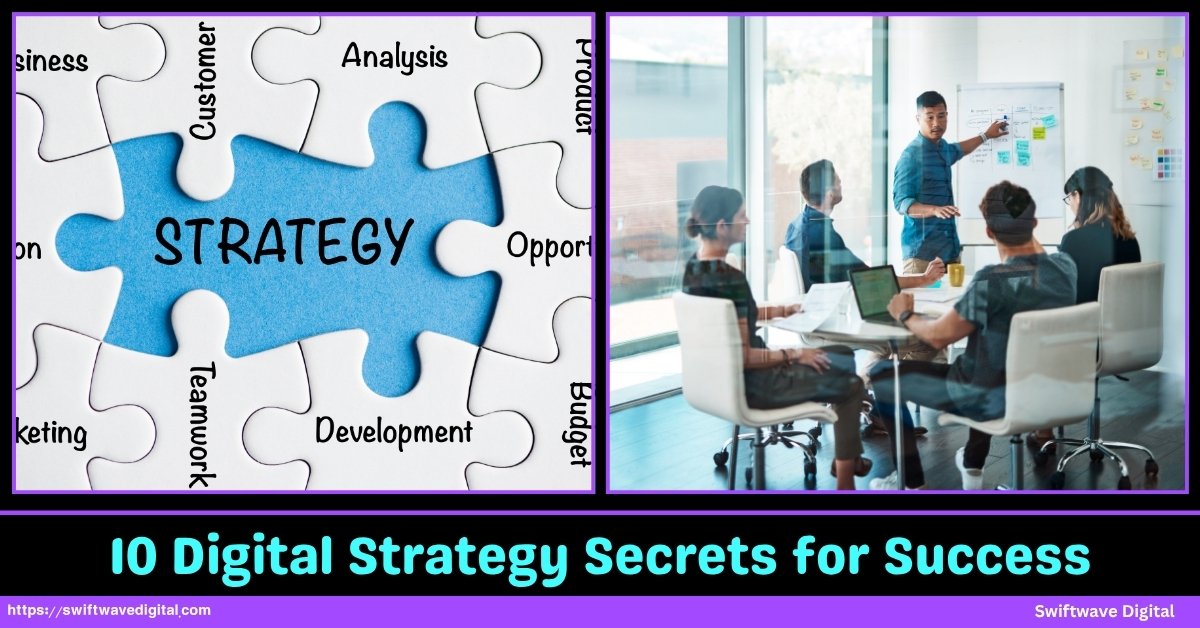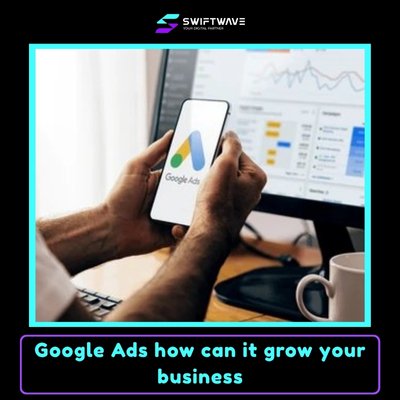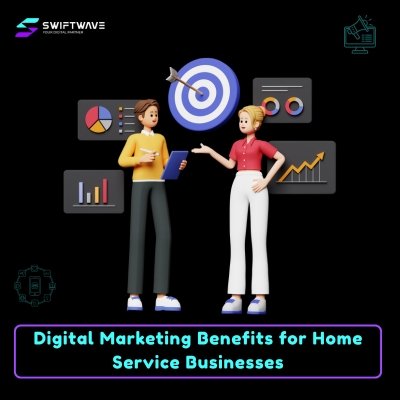Digital Strategy is the backbone of every successful business in today’s hyper-connected world. It’s not just about running ads or posting content it’s about having a structured, data-driven approach to how your brand operates, communicates, and grows online.
A strong digital strategy defines your goals, identifies your target audience, and aligns every digital channel from SEO and social media to paid ads and automation toward measurable outcomes.
Businesses that rely on guesswork or outdated tactics often lose traction, while those that use real data, testing, and integration see consistent growth and stronger ROI.
With digital platforms evolving faster than ever, companies must adapt, optimize, and focus on long-term sustainability, not just short-term clicks.
Whether you’re a marketer, entrepreneur, or business owner, understanding these strategic fundamentals is no longer optional it’s essential for survival and success in 2025 and beyond.
10 Digital Strategy Secrets for Success
In this guide, we will explain 10 Digital Strategy Secrets for Success that can help your business stay ahead of the competition.

1. Start with Clarity of Objective, Not Tactics
A successful digital strategy always begins with clarity of purpose. Too many businesses rush into running ads, launching social media campaigns, or creating content without knowing exactly why they are doing it.
This lack of direction leads to wasted budgets and scattered results. Before you touch a single platform, define your business objectives in precise, measurable terms.
Objectives like “increase online sales by 30% in six months” or “generate 500 qualified leads per quarter” are clear, actionable, and measurable. When you start with objectives, your tactics naturally align to serve those goals.
A strong framework such as SOSTAC which stands for Situation, Objectives, Strategy, Tactics, Action, and Control helps structure everything logically.
It ensures that you move from identifying your current state to planning your goals, developing your strategy, and tracking outcomes.
Every action you take should directly connect to the business metrics that matter most, such as sales, revenue, customer retention, or market share. Without this clarity, your digital strategy turns into guesswork, and guesswork doesn’t scale.
2. Know Your Audience (Deeply)
Digital success depends on how well you understand your audience. The brands that outperform others know their customers’ needs, motivations, and frustrations better than anyone else.
Knowing your audience is not about surface-level demographics like age or location; it’s about understanding behaviors, pain points, and decision triggers.
Use every tool available from Google Analytics and CRM data to social listening and surveys to collect insights. Segment your audience by their interests, spending patterns, and stages in the buying journey.
Understanding your audience lets you speak their language, address their problems, and appear where they spend time online. When you know who you are talking to, your content becomes sharper, your ad targeting becomes efficient, and your conversions improve.
A clear audience profile acts as a compass, guiding every decision from choosing ad platforms to designing landing pages. The deeper your insight, the greater your competitive edge.
3. Embrace Personalization at Scale
Modern consumers expect personalized experiences. They want brands to understand their preferences and deliver relevant messages without being intrusive.
Personalization goes beyond using someone’s name in an email; it involves tailoring offers, product recommendations, and communication based on past behavior, purchase history, or browsing activity.
When implemented correctly, personalization boosts engagement and increases conversions because users feel understood. For instance, an online store that recommends products based on browsing habits or purchase history naturally attracts repeat buyers.
However, personalization must be used wisely. Irrelevant or overly aggressive targeting can backfire and make your brand appear careless or invasive.
Balance automation with authenticity, and always ensure data privacy compliance. Personalization at scale is about combining data and empathy using technology to deliver experiences that genuinely serve users rather than overwhelm them.
When done right, it transforms occasional visitors into loyal customers who trust your brand.
4. Combine Organic and Paid in a Unified Funnel
A powerful digital strategy doesn’t rely on either organic or paid marketing alone; it integrates both seamlessly.
Organic channels like SEO, content marketing, and social media help build trust, authority, and long-term visibility, while paid channels such as Google Ads and Meta Ads deliver fast exposure and measurable traffic.
When these two forces work together, they create a self-sustaining funnel. You can use paid campaigns to test messaging quickly, gather data, and drive short-term results while letting organic content build steady brand awareness over time.
For example, high-performing blog articles can be promoted through paid ads to reach new audiences, while insights from paid campaigns can guide organic content creation.
A unified funnel ensures that no effort is wasted your content supports your ads, your ads amplify your content, and both feed into conversions.
This approach not only maximizes your reach but also creates consistency across the customer journey, from discovery to purchase.
5. Optimize for AI and Generative Search
Artificial Intelligence is redefining how people discover and interact with information. Search engines are evolving into generative engines that summarize answers rather than listing links.
This shift demands a new kind of optimization: Generative Engine Optimization (GEO). To stay visible in this landscape, your content must be factual, concise, and structured in a way that AI can easily interpret.
Write content that directly answers user queries, supports claims with credible data, and maintains clarity in structure. Schema markup, clear headings, and authoritative backlinks all increase your chances of being cited by AI-powered search tools.
Instead of stuffing keywords, focus on semantic relevance and authority. AI-driven search prioritizes trustworthy, expert content that demonstrates reliability.
Businesses that adapt early to this evolution will gain an advantage as traditional search becomes less dominant.
Optimizing for AI is not about gaming the system but aligning your brand with how users now consume information through quick, credible, machine-generated insights.
6. Use Video and Visual Content Aggressively
Video has become the most dominant form of online communication because it captures attention faster and retains it longer than text or images. Audiences today scroll past static posts but stop for motion, sound, and storytelling.
Whether it’s product demos, tutorials, customer testimonials, or brand stories, video enhances engagement across every platform.
Short-form videos on Instagram Reels, TikTok, and YouTube Shorts are particularly effective for building awareness, while longer videos on YouTube or your website can educate and convert viewers.
Visual content like infographics and animations can also simplify complex information, making your brand appear more approachable and informative.
You don’t need a massive production budget to create effective videos; clarity and authenticity often outperform polished perfection.
Regular video updates help humanize your brand, showcase expertise, and build emotional connection. In a digital environment dominated by short attention spans, video is not an optional extra it’s a core growth engine.
7. Automate and Test Like Crazy
Efficiency and adaptability define winning digital strategies. Automation allows you to operate consistently, while testing ensures you’re moving in the right direction.
Automation tools can handle repetitive tasks such as email marketing sequences, lead nurturing, social scheduling, and bid management, freeing your team to focus on strategy.
However, automation without experimentation is ineffective. A/B testing should be part of your routine. Test different headlines, calls to action, images, and formats to identify what works best.
Small, continuous experiments produce valuable insights over time and prevent wasted spending. Automation ensures that campaigns run smoothly, while testing fine-tunes them for maximum performance.
Together, they create a cycle of improvement that compounds results. The digital landscape rewards brands that learn fast and adapt faster, and both automation and testing are the tools that make that possible.
8. Measure the Right Metrics and Kill Vanity Metrics
What you measure defines what you improve. Many businesses focus on vanity metrics — likes, followers, impressions — that make reports look impressive but have no impact on profitability.
A smart digital strategy focuses only on metrics tied to revenue, retention, and efficiency. Track data such as cost per lead, conversion rate, customer acquisition cost, and lifetime value.
These numbers reveal whether your marketing efforts are genuinely contributing to growth. Use advanced analytics tools to trace customer journeys from the first interaction to purchase, ensuring you understand which channels deliver actual results.
Reviewing this data regularly allows for quick adjustments in campaigns and budgets. Digital strategy is about informed decision-making; if your analytics aren’t driving actions, they’re just noise.
By eliminating vanity metrics and focusing on real performance indicators, you ensure every move in your strategy serves a clear business purpose.
9. Build for Flexibility and Adapt Fast
Change is constant in digital marketing. Algorithms shift, new technologies emerge, and audience preferences evolve rapidly. A rigid strategy collapses under this pressure, while a flexible one thrives.
Building flexibility means adopting an agile mindset planning in shorter cycles, reviewing results frequently, and pivoting when necessary. Rather than committing your entire budget to a single approach, reserve a portion for experimentation.
Test new ad platforms, explore trending formats, and monitor emerging opportunities. When a trend shows consistent potential, scale it quickly; when it fails, move on without delay.
Flexibility also means maintaining adaptable assets templates, modular content blocks, and automated workflows that can easily be modified.
The brands that succeed long-term are those that treat digital strategy as a living process, not a one-time document. The ability to respond quickly to change will always be more valuable than sticking to a perfect but outdated plan.
10. Focus on Trust, Reputation, and Community
Trust has become the strongest currency in digital marketing. People buy from brands they believe in, not just those with the best ads. Every interaction your brand has through social media, reviews, customer support, or content either builds or erodes that trust.
Maintaining transparency in how you operate, communicate, and handle customer feedback is essential. Responding honestly to negative reviews or addressing concerns directly demonstrates accountability and maturity.
Building a reputation takes time, but once established, it becomes a powerful growth asset. Beyond trust, building a community around your brand deepens loyalty.
Online communities, discussion groups, and social platforms turn customers into advocates who share experiences and recommend your products.
Encouraging user-generated content, testimonials, and open conversations creates authenticity that no advertisement can replicate.
In a digital world filled with noise, trust and community give your brand the long-term stability that constant paid promotion cannot buy.
Bringing It All Together: Execution Steps
Executing a digital strategy effectively requires coordination, consistency, and continuous refinement.
Start by conducting a complete audit of your current performance review your website analytics, social media presence, paid ad data, and customer feedback to understand where you stand.
Then define clear, measurable objectives tied to business outcomes. Align your channels SEO, paid media, email, and content to work toward these same goals instead of operating separately.
Implement automation where possible, but maintain human oversight for quality and brand voice. Track progress weekly or bi-weekly to catch performance issues early.
Adjust budgets and messaging based on what the data tells you, not personal preference. Keep refining your content and testing new creative angles.
The process is ongoing digital strategy isn’t a project you finish; it’s a cycle of planning, execution, measurement, and improvement. By maintaining discipline and agility, your efforts stay aligned and effective.
Pitfalls You Must Avoid
Even the most detailed digital plan can fail if you fall into common traps. One major mistake is chasing trends without understanding their relevance to your business.
Every new app or feature isn’t automatically worth investing in. Another frequent error is ignoring mobile optimization the majority of users interact through mobile devices, and a slow or cluttered experience immediately kills conversions.
Many brands also rely too heavily on paid ads, forgetting that organic growth builds credibility and resilience. Others neglect data privacy, which damages trust and invites compliance issues.
Perhaps the most dangerous pitfall is failing to adapt; sticking to last year’s playbook in a fast-moving environment guarantees decline. Avoiding these mistakes keeps your strategy stable and your results sustainable.
Digital strategy is less about perfection and more about awareness knowing what to pursue, what to pause, and what to drop entirely.
Real-World Evidence and Data Insights
Industry data proves that structured digital strategies deliver real results. As of 2025, digital advertising accounts for over 73% of global ad spend, confirming that digital is no longer just one component of marketing it’s the core.
Research also shows that 86% of marketers now use video as part of their strategy, and 81% report direct sales increases from it. SEO remains powerful, with 89% of marketers calling it effective for long-term visibility and credibility.
The growing emphasis on privacy-first marketing, identified by Deloitte, also indicates that trust and compliance are now competitive advantages, not just legal requirements.
These numbers demonstrate that digital growth depends on clear objectives, audience understanding, integrated channels, and consistent measurement.
The data makes it simple: strategy backed by structure and adaptability always outperforms random tactics and guesswork.
Conclusion
Building a powerful digital strategy is not about using every new tool or chasing every emerging trend it’s about clarity, focus, and consistency.
Businesses that win in the digital age are those that set measurable goals, understand their audience deeply, and build systems that adapt as technology and consumer behavior evolve.
Every channel, whether organic or paid, must work toward the same objective: delivering value that drives real business outcomes. Automation, testing, and data-driven decisions form the foundation, but trust and authenticity give your brand its staying power.
Success in digital marketing is never accidental it’s engineered through structure, discipline, and continuous learning.
The market will keep changing, algorithms will keep shifting, and competition will intensify, but a strategy built on these principles will keep you moving forward.
In 2025 and beyond, digital excellence belongs to those who plan with precision, execute with consistency, and optimize relentlessly.



